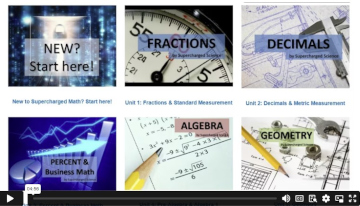Supercharged Math offers online math for students in grades four through eight, both live and recorded. Students beginning the program should have mastered addition, subtraction, multiplication, and division of whole numbers. This review is based on the recorded videos, although the primary course instructor, Aurora Lipper, encourages students to begin by attending a live session, then working independently if they wish.
Students learn the mechanics of mathematical calculations, but this program places a heavy emphasis on solving problems based on real-life applications. Students should gain an appreciation of why they need to learn math and how they can use it.
Program Design
The design of the program is unique and very flexible. Students should work at their own pace at whatever level is appropriate for them.
The program is arranged under topics: fractions, decimals, percents, algebra, and geometry. PDF workbook pages for each topic are available under either “Grades 4-6th Workbooks” or “Grades 7-8th Workbooks.” Usually, students up through sixth grade will work on the first three areas, while seventh and eighth grades tackle algebra and geometry. The divisions between topics are often fuzzier than it sounds. For instance, older students might benefit from the advanced activities for fractions, decimals, and percents.
Generally, those new to a concept start with beginner assignments and follow up with intermediate assignments on the same topic. Beginner sessions assume students are new to the topic and teach sequentially. The intermediate level builds on that foundation and introduces some real-world applications. The advanced level takes students deeper with real-world applications, many related to science and engineering. After they’ve mastered beginner and intermediate assignments (or tested out) for all sessions on that topic, students go back and work through the advanced assignments on that same topic. Students who have already mastered a topic can begin with advanced sessions that are based entirely on applications.
There are seven sessions for every topic, and sessions can take from one to six weeks depending on the student's proficiency. Students will work through one topic at a time, but those topics will be revisited later. Each topic begins with an optional parent video that explains what students will learn. More important than the parent video is the link below the video where you can download a one-page Math Assignments Outline with a menu of assignments from which students or parents select those most useful.
All students begin a topic by watching a video. Initial presentations are taught by Lipper, and two other instructors present other sessions and help lead tutorials. If students are at intermediate or advanced levels, they can start with the video for the appropriate level. Videos run about 30 to 40 minutes, and students will generally watch two per week. Students will work on two to five workbook pages every day if they are learning new concepts. As students begin to work on math labs and applications, they complete fewer pages per day.
After watching the video, students tackle assignments in workbook pages downloaded for each session. Workbook pages, developed specifically for this program by Lipper, include practice problems as well as games, puzzles, activities, and math labs. The last two or three pages of each set of workbook pages are a test. If students need more help with workbook activities, they can watch additional videos in which Lipper walks students step by step through the workbook pages. If students think concepts in the workbook look too easy for them, they can jump ahead to the test—testing out of the session if they have already mastered the material.
Students should have a binder for each topic in which they will insert their workbook pages. In addition to standard school supplies and the binders, students will need a protractor, a compass, a ruler (with both metric and standard measurements), grid paper, index cards, string, and dice (10-sided, 12-sided, or a polyhedral set).
Grading and Oversight
Students are provided with answer keys so they can check their own work. A grade sheet is included in the Curriculum Guide Packet along with an explanation of how students can track their own progress. (Parents can help as needed or keep records themselves.) You can watch the course’s video on assessment for more information.
Most students will need parental assistance at first to figure out how the program operates, but they should gradually be able to work more independently. Optional, small-group, private tutoring sessions are available each week.
Summary
Supercharged Math exceeds the Common Core Standards for Math, although it is not designed to align with them. (Parents can see where many of the standards are taught in the program if they need that information.) Instead, it is based on the math and thinking skills required for science and engineering students in college. Learning those skills should translate into a practical knowledge of math rather than mastery of skills for which students might see no need.










